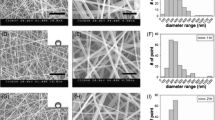Abstract
The central nervous system (CNS), once injured, rarely recovers original function mainly due to its limited regeneration ability. Astrocytes are cells that play critical roles in neural regeneration. Several biomaterials have been studied to replace and regenerate lost tissues within injured CNS. Seaweeds have extracellular polymeric substances (EPS) with bioactive properties such as antiviral and antioxidant properties. In this study, astrocyte activity was assessed, after being cultured on an electrospun polycaprolactone (PCL) nanofibrous mat containing a brown seaweed EPS. Laminarin and fucoidan, two main components of EPS extract from the brown seaweed, were concluded to increase or decrease astrocyte activity with respect to their concentration. When the concentration was under 10 μg/ml, the astrocytes tended to increase their viability. In contrast, over 10 μg/ml EPS in media suppressed the viability of astrocytes. In addition, when contained in PCL nanofiber, the EPS extract was also proven to influence astrocyte activity in the same way as the case when astrocytes were exposed to EPS in solution. This implies that the brown seaweed EPS–PCL nanofiber mat can be used for temporal control of astrocyte activity by EPS concentration. Through this research, we propose that the electrospun EPS–PCL nanofiber could be used as a nanomedicine or scaffold to treat CNS injuries.





Similar content being viewed by others
References
Bundesen L. Q. et al. Ephrin-B2 and EphB2 regulation of astrocyte-meningeal fibroblast interactions in response to spinal cord lesions in adult rats. J. Neurosci. 23: 7789–7800; 2003.
Chen J.-P.; Chang Y.-S. Preparation and characterization of composite nanofibers of polycaprolactone and nanohydroxyapatite for osteogenic differentiation of mesenchymal stem cells. Colloid. Surface. B. 86: 169–175; 2011.
Christopherson K. S. et al. Thrombospondins are astrocyte-secreted proteins that promote CNS synaptogenesis. Cell 120: 421–433; 2005.
Clements I. P. et al. Thin-film enhanced nerve guidance channels for peripheral nerve repair. Biomaterials 30: 3834–3846; 2009.
Fujiki K. et al. Effect of hot-water extracts from marine algae on resistance of carp and yellow tail against bacterial infections. Sci. Bull. Fac. Agric. Kyushu Univ. Jpn. 47: 137–141; 1992.
Hurtado A. et al. Robust CNS regeneration after complete spinal cord transection using aligned poly-l-lactic acid microfibers. Biomaterials 32: 6068–6079; 2011.
Liberto C. M. et al. Pro-regenerative properties of cytokine-activated astrocytes. J. Neuro. Chem. 89: 1092–1100; 2004.
Madigan N. N. et al. Current tissue engineering and novel therapeutic approaches to axonal regeneration following spinal cord injury using polymer scaffolds. Resp. Physiol. Neurobi. 169: 183–199; 2009.
Maier I. C.; Schwab M. E. Sprouting, regeneration and circuit formation in the injured spinal cord: factors and activity. Philos. T. R. Soc. B. 361: 1611–1634; 2006.
McCarthy K. D.; de Vellis J. Preparation of separate astroglial and oligodendroglial cell cultures from rat cerebral tissue. J Cell Biol. 85:890-902, 1980
Mukhopadhyay G. et al. A novel role for myelin-associated glycoprotein as an inhibitor of axonal regeneration. Neuron 13: 757–767; 1994.
Pham Q. P. et al. Electrospinning of polymeric nanofibers for tissue engineering applications: a review. Tissue Eng. 12: 1197–1211; 2006.
Reier P. J.; Houle J. D. The glial scar: its bearing on axonal elongation and transplantation approaches to CNS repair. Adv. Neurol. 47: 87–138; 1988.
Rupérez P. et al. Potential antioxidant capacity of sulphated polysaccharides from the edible marine brown seaweed Fucus vesiculosus. J. Agric. Food Chem. 50: 840–845; 2002.
Schmidt C. E.; Leach J. B. Neural tissue engineering: strategies for repair and regeneration. Annu. Rev. Biomed. Eng. 5: 293–347; 2003.
Schwab M. E. Repairing the injured spinal cord. Science 295: 1029–1031; 2002.
Toskas G. et al. Nanofibers based on polysaccharides from the green seaweed Ulva rigida. Carbohydr. Polym. 84: 1093–1102; 2011.
Tysseling-Mattiace et al. Self-assembling nanofibers inhibit glial scar formation and promote axon elongation after spinal cord injury. J. Neurosci. 28: 3814–3823; 2008.
Wang H. B. et al. Creation of highly aligned electrospun poly-L-lactic acid fibers for nerve regeneration applications. J. Neural Eng. 6: 016001; 2009.
Wu V. W.; Schwartz J. P. Cell culture models for reactive gliosis: new perspectives. J. Neuro. Sci. Res. 51: 675–681; 1998.
Zhang D. et al. Astrogliosis in CNS pathologies: is there a role for microglia? Mol. Neurobiol. 41: 232–241; 2010.
Acknowledgments
This research was supported by grants from the Marine Biotechnology Program funded by the Ministry of Land, Transport and Maritime Affairs, Korea, and by Inha University Research Grant.
Author information
Authors and Affiliations
Corresponding author
Additional information
Editor: T. Okamoto
Rights and permissions
About this article
Cite this article
Jung, SM., Kim, S.H., Min, S.K. et al. Controlled activity of mouse astrocytes on electrospun PCL nanofiber containing polysaccharides from brown seaweed. In Vitro Cell.Dev.Biol.-Animal 48, 633–640 (2012). https://doi.org/10.1007/s11626-012-9566-0
Received:
Accepted:
Published:
Issue Date:
DOI: https://doi.org/10.1007/s11626-012-9566-0




